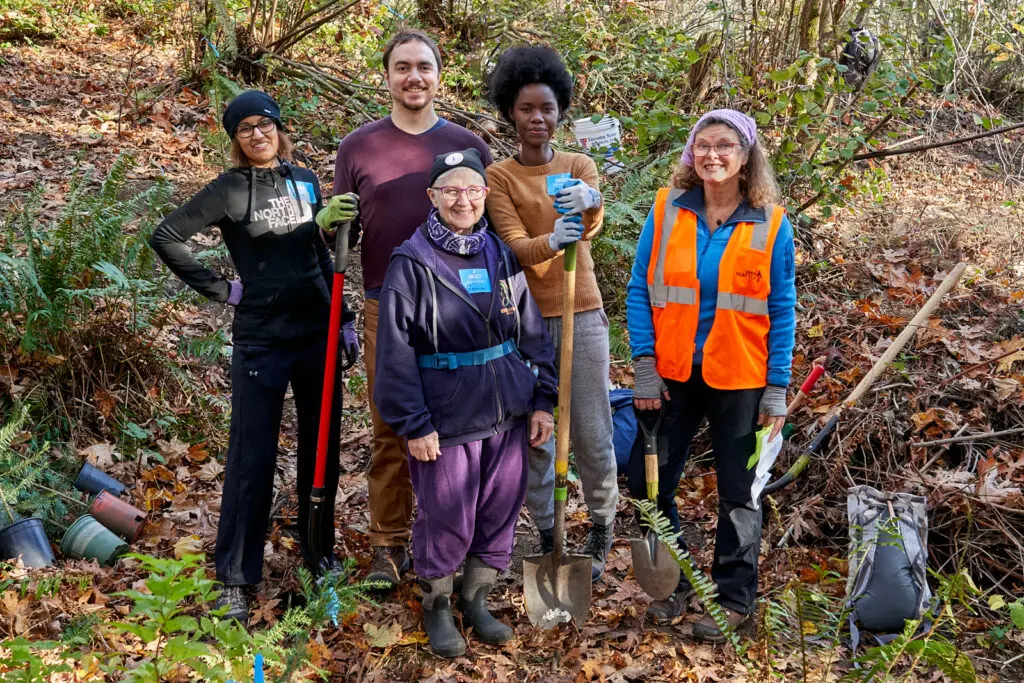Written By Daniel Beekman – Seattle Times staff reporter
DARRINGTON — Once upon a time, timber made Darrington. Now, it could remake Darrington.
That’s the story Mayor Dan Rankin tells as he walks through the woods outside his mountain-rimmed community, which for decades has struggled with the decline of its old-school logging industry and which was traumatized eight years ago Tuesday by the deadliest landslide in U.S. history.
Rankin is the driving force behind a $120 million plan to develop a manufacturing hub for cross-laminated timber panels and modular housing. Work should break ground soon in the small Snohomish County town, which was Ground Zero for the landslide’s emergency response.
Backed by the Seattle-based nonprofit Forterra, the Darrington Wood Innovation Center is supposed to invigorate the area with new technology and a more environmentally responsible approach, using timber from conservation harvesting to produce the panels, the panels to produce modular units and the units to build affordable housing across Washington. It’s an exciting enterprise, though there are uncertainties.
Rankin wants to demonstrate how a rural community can thrive without discarding its heritage. While Darrington is also trying to attract tourists and the county has secured a state grant to support the installation of fiber-optic internet along the Highway 530 corridor, the mayor calls timber “part of our DNA.” The CLT project is supposed to yield more than 120 jobs.
“To be authentic to the generations that came before you, you need industry,” the former logger said. “You need work that people can believe in.”
In conservation harvesting, or “thinning,” certain trees are removed from unnaturally dense stands that were planted after clear-cutting decades ago. That can help the remaining trees grow larger and older, said Washington Wild executive director Tom Uniack, whose environmental organization supports some thinning specifically on U.S. Forest Service lands as part of a “dogs and cats” collaborative of unlikely allies that also includes Rankin and a local logging contractor.
In CLT manufacturing, sheets of wood planks are stuck crosswise over each other and subjected to pressure or high-frequency waves. Computers cut the super strong, fire-resistant panels to size, with openings for doors, windows, wires — even screws.
Forterra is championing the plan partly because CLT can reduce the construction sector’s reliance on concrete and steel, which require a lot of pollution to make, said Tobias Levey, the nonprofit’s vice president of real estate transactions. Some University of Washington research has buttressed that idea, with caveats.
“It’s this incredibly basic material, just wood glued together,” Levey said. “But it can have this very dramatic effect.”
The market for CLT in the U.S. is embryonic and modular housing is a new line of business for Forterra, which is partnering with European companies. Certain researchers have questioned the extent of the sustainability benefits, while others are supportive.
Rankin has high hopes. In theory, the Darrington hub will eventually include a vocational component to train local students for high-tech jobs and draw them back as adults. Today, many leave after high school, “never to return,” he said.
Showing Tenacity
Tucked between snow-capped peaks where the Sauk and Stillaguamish river valleys meet, an hour and a half northeast of Seattle, Darrington was established in the 1890s and grew with the timber industry. “Home of the Loggers” reads the side of the community center where the town’s high-school basketball teams play.
Once thriving, the town was pummeled by the “owl wars” of the 1980s and 1990s, Rankin said, when loggers and environmentalists battled over how to manage the forests of the Pacific Northwest and protect animals. Today, Darrington has one supermarket and one gas station. Mountain ramparts loom above a square-mile street grid lined with low-slung houses.
There’s still a sawmill, owned by Hampton Lumber, that remains the town’s largest employer. But the median household income is about $37,700, half the statewide median, and the poverty rate is 20%, double the statewide rate, according to census estimates from 2019.
Housing costs have increased, under pressure from prices “down below,” in urban Snohomish County. Homelessness, too. Though many residents commute to Arlington and beyond, only one bus leaves town each morning.
Marree Perrault, program manager at North Counties’ Family Services in Darrington, sees the town’s problems up close when parents stop by for help.
“We have million-dollar views up here, but not enough living-wage jobs to pay for them,” said Perrault. “A lot of our kids are hurting.”
The CLT plan and other community initiatives took shape, Rankin said, after a hillside collapsed between Darrington and Oso, destroying dozens of residences, killing 43 people and shutting down Highway 530 for months. The disaster known as the Oso landslide was a nightmare, but the way people in the area supported each other through tragedy was in Rankin’s view a “horrible success,” he said.
“We brought everybody home,” the mayor said, referring to a harrowing effort that reclaimed every victim from the debris. “Everything stemmed from that … We showed the world our tenacity.”
Rankin’s nephew, Oak Rankin, launched the Glacier Peak Institute, which connects kids to science and math through the outdoors. The state funded a $150,000 tourism campaign, touting the area’s bluegrass festival and hiking trails. The town built a new skateboard park and helped open 10 miles of mountain-biking trails. Sudden interest from powerful people (even then-President Barack Obama visited) meant, “We were able to start taking ideas off the shelf” and make progress, Dan Rankin said.
That partly saddens Dayn Brunner, a resident who lost his sister in the slide. While he wants to see positive changes, it shouldn’t have taken “43 victims and 11 survivors,” he said, “to put Darrington on the map.”
Next Steps
Rankin zeroed in on CLT not long after the slide (logging was alleged to have played a role in the calamity, though there were slides at the site before logging began), but the plan didn’t coalesce right away. He and the county pitched multiple industry players before Forterra got involved, he said. Even now, the plan is delicately balanced.
Darrington bought and will prep the 94-acre site using about $10 million in federal, state and county funds, with bids for that initial work due last week.
The town will lease the land to a Forterra entity, which on about 30 acres will build a CLT factory with a small sawmill and a modular-housing factory. The Forterra entity will rent the CLT factory to a joint venture with a German company, and rent the modular factory to a Swiss company.
Those costs could total about $110 million, with Forterra social-impact investors contributing. There are $68 million in loans currently pending, according to Forterra.
Thirty acres will be conserved, and the rest could be developed for wood-products education and research, though details have yet to solidify. Washington State University would make sense as a partner because the school’s Pullman campus includes a lab stocked with experts and its Snohomish County extension is active in Darrington.
Meanwhile, the town is buzzing about the plan. Jobs are needed, so the project makes sense, as long as the forests cared for and restored, said Nino Maltos, chairman of the area’s Sauk-Suiattle Indian Tribe. Many Darrington residents are change-averse, but Perrault, with North Counties’ Family Services, is thinking, “Let’s give this a shot,” she said.
Tracy Franke, superintendent for the Darrington School District, is thinking the same about the internet project. When COVID-19 shuttered classes in 2020, teachers posted lessons online. But 1 in 3 of their students had to pick up flash drives in person, because they had no or inadequate internet, Franke said.
In January, the state allocated $16 million to help Ziply Fiber install broadband infrastructure from Arlington through Darrington by 2024, adding access to thousands of homes and businesses. The project will cost about $28 million, according to Ziply, with corporate and federal funds also involved.
Better service could boost tourism. There are short-term rentals popping up, like those run by Lynne Green, who left Seattle in 2016 to start a sheep farm near Darrington. Tech workers are starting to move in, added Catherine Thuline, who helps with the farm.
The future?
Though Rankin supports the Ziply project, he says the infrastructure built with public dollars should be open to competitors, to promote affordability.
Sophia Archambault, a San Francisco transplant who lives near Darrington, worries the state could be wasting money on inferior internet. She and her husband use and are pleased with Elon Musk’s satellite service, which isn’t cheap, but is targeting rural areas.
Ziply will offer 200 megabits per second for $40 monthly and 1 gigabit at $60, with more powerful service available, chief executive Harold Zeitz said.
Variables for the CLT project include the pending loans, the wood supply and the market.
“The biggest challenge” for any mill is timber supply, said Kristin Rasmussen, a Hampton spokesperson.
The CLT factory hopes to get wood from “private and institutional landowners,” plus federal and state lands, Levey said; Forterra just worked on a 12,000-acre purchase by the Snoqualmie Indian Tribe.
There are other CLT manufacturing hubs in the Pacific Northwest already, said Karl Englund, a WSU researcher. But demand could take off soon, creating “plenty of room in the market,” said Todd Beyreuther, product director at a Spokane factory.
The modular units can be stacked like Lego blocks to reduce construction costs, Levey said. Forterra has committed to developing 300 affordable apartments in Tacoma and 100 in Tukwila that way. The annual manufacturing target will be about 800 homes, Levey said.
Mark Harmon, an Oregon State University professor emeritus of forest ecosystems, worries that some CLT advocates may be using green arguments to justify logging. They contend timber buildings can combat climate change by sequestering atmospheric carbon, but leaving a tree in the forest to decay can yield similar results, Harmon said, depending on the type of tree, environment and building compared.
Still, what makes the Darrington project so compelling, said Snohomish County Executive Dave Somers, is the “blending of tech and natural resources.”
“In my mind,” Somers said while checking out a prototype CLT home in an Everett warehouse in January, “this is the future.”
MORE INFORMATION
Darrington Wood Innovation Center
Cross Laminated Timber
Forterra’s Forest to Home Model
DWIC Announcement Press Release
ABOUT TOWN OF DARRINGTON
Darrington, a small mountain town in the North Cascades, sits between the Sauk and the North Fork Stillaguamish rivers. Today, the town has about 1,405 residents and serves another 1,200 folks in the surrounding areas. The primary economy is still the timber industry; however, Darrington is also using its unique location near the Mt. Baker-Snoqualmie National Forest, Wild and Scenic Rivers, and Wilderness to promote recreation as a strong force in the local economy. Learn more at www.townofdarrington.com.
ABOUT FORTERRA
Forterra is an unconventional land trust that works across Washington’s communities and landscapes, from the ranches and shrub-steppe of the Yakima basin, to the estuaries, farms and forests of Washington’s coast, reaching more than 100 counties, cities, towns and rural communities. Working cooperatively with people and nature, Forterra drives land stewardship, management and planning, innovative programs and policies, farming and forestry approaches, community ownership opportunities, and development solutions. Visit www.forterra.org.



